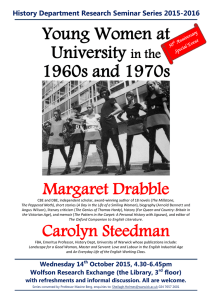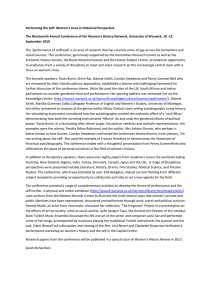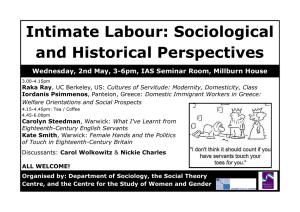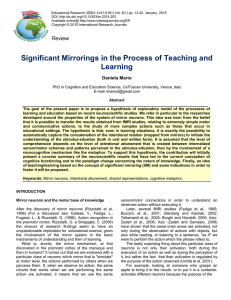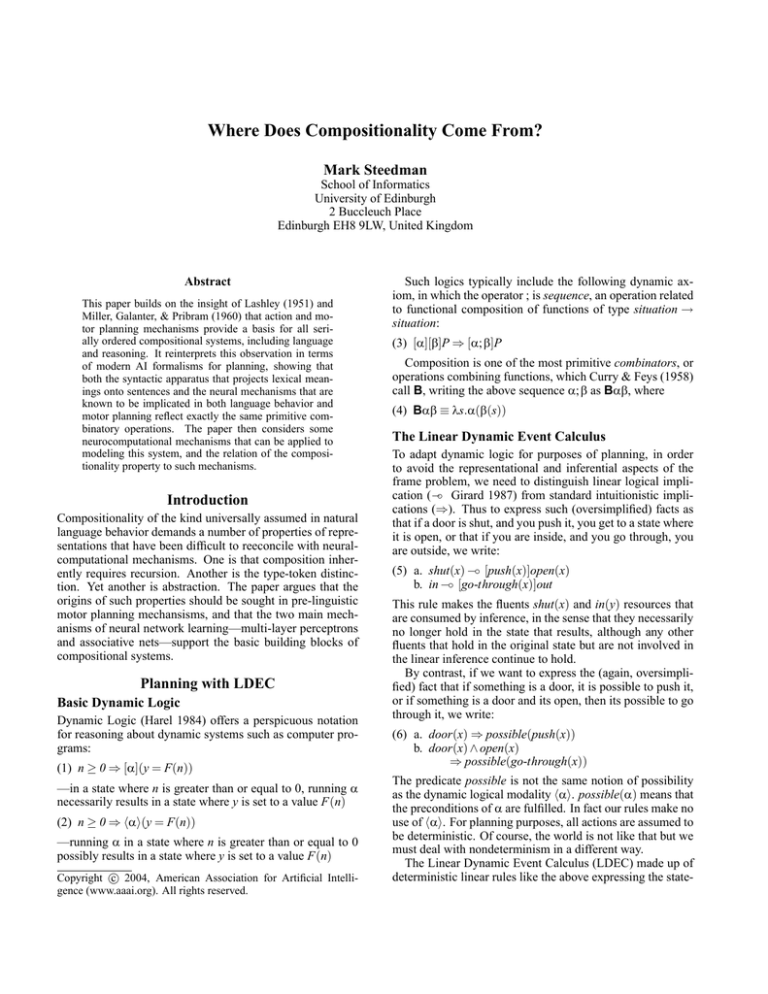
Where Does Compositionality Come From?
Mark Steedman
School of Informatics
University of Edinburgh
2 Buccleuch Place
Edinburgh EH8 9LW, United Kingdom
Abstract
This paper builds on the insight of Lashley (1951) and
Miller, Galanter, & Pribram (1960) that action and motor planning mechanisms provide a basis for all serially ordered compositional systems, including language
and reasoning. It reinterprets this observation in terms
of modern AI formalisms for planning, showing that
both the syntactic apparatus that projects lexical meanings onto sentences and the neural mechanisms that are
known to be implicated in both language behavior and
motor planning reflect exactly the same primitive combinatory operations. The paper then considers some
neurocomputational mechanisms that can be applied to
modeling this system, and the relation of the compositionality property to such mechanisms.
Introduction
Compositionality of the kind universally assumed in natural
language behavior demands a number of properties of representations that have been difficult to reeconcile with neuralcomputational mechanisms. One is that composition inherently requires recursion. Another is the type-token distinction. Yet another is abstraction. The paper argues that the
origins of such properties should be sought in pre-linguistic
motor planning mechansisms, and that the two main mechanisms of neural network learning—multi-layer perceptrons
and associative nets—support the basic building blocks of
compositional systems.
Planning with LDEC
Basic Dynamic Logic
Dynamic Logic (Harel 1984) offers a perspicuous notation
for reasoning about dynamic systems such as computer programs:
(1) n ≥ 0 ⇒ [α](y = F(n))
—in a state where n is greater than or equal to 0, running α
necessarily results in a state where y is set to a value F(n)
(2) n ≥ 0 ⇒ hαi(y = F(n))
—running α in a state where n is greater than or equal to 0
possibly results in a state where y is set to a value F(n)
c 2004, American Association for Artificial IntelliCopyright gence (www.aaai.org). All rights reserved.
Such logics typically include the following dynamic axiom, in which the operator ; is sequence, an operation related
to functional composition of functions of type situation →
situation:
(3) [α][β]P ⇒ [α; β]P
Composition is one of the most primitive combinators, or
operations combining functions, which Curry & Feys (1958)
call B, writing the above sequence α; β as Bαβ, where
(4) Bαβ ≡ λs.α(β(s))
The Linear Dynamic Event Calculus
To adapt dynamic logic for purposes of planning, in order
to avoid the representational and inferential aspects of the
frame problem, we need to distinguish linear logical implication (−◦ Girard 1987) from standard intuitionistic implications (⇒). Thus to express such (oversimplified) facts as
that if a door is shut, and you push it, you get to a state where
it is open, or that if you are inside, and you go through, you
are outside, we write:
(5) a. shut(x) −◦ [push(x)]open(x)
b. in −◦ [go-through(x)]out
This rule makes the fluents shut(x) and in(y) resources that
are consumed by inference, in the sense that they necessarily
no longer hold in the state that results, although any other
fluents that hold in the original state but are not involved in
the linear inference continue to hold.
By contrast, if we want to express the (again, oversimplified) fact that if something is a door, it is possible to push it,
or if something is a door and its open, then its possible to go
through it, we write:
(6) a. door(x) ⇒ possible(push(x))
b. door(x) ∧ open(x)
⇒ possible(go-through(x))
The predicate possible is not the same notion of possibility
as the dynamic logical modality hαi. possible(α) means that
the preconditions of α are fulfilled. In fact our rules make no
use of hαi. For planning purposes, all actions are assumed to
be deterministic. Of course, the world is not like that but we
must deal with nondeterminism in a different way.
The Linear Dynamic Event Calculus (LDEC) made up of
deterministic linear rules like the above expressing the state-
changing effects of instantaneous1 actions, and intuitionistic rules expressing the preconditions on those actions taking place makes a very transparent notation for STRIPS-like
knowledge for constructing plans, via the following axiom
expressing the transitivity property of the possible relation:
(7) |= possible(α) ∧ [α]possible(β) ⇒ possible(α; β)
This says that if you are in a state where its possible to α and
its a state in which actually α-ing gets you to a state where
its possible to β, you are in a state where it is possible to α
then β.
It supports a simple planner in which starting from the
world (8) in which I am in, and the door is shut and stating the goal (9) meaning “find a possible series of actions
that will get me out,” can be made to automatically deliver a
constructive proof that one such plan is (10):
theory, all language specific information resides in the lexicon. For example, the fact that the English transitive clause
exhibits SVO word-order is captured as follows in the lexical category for transitive verbs, which comprises a syntactic
type (to the left of the colon) and a semantic interpretation
(to the right):
(15) like := (S\NP)/NP : like0
The following Combinatory Rules combine such functor categories with arguments:2
X/Y : f Y : g
Y : g X\Y : f
>
<
X : f (g)
X : f (g)
X/Y : f Y /Z : g
>B
X/Z : λz. f (g(z))
X/Y : f Y \Z : g
>B×
X\Z : λz. f (g(z))
(8) in ∧ door(d) ∧ shut(d)
(9) possible(α) ∧ [α]out
Crucially, all arguments are type-raised via the lexicon:
(10) α = push(d); go-through(d).
The situation that results from executing this plan in the start
situation (8) is one in which the following conjunction of
facts is directly represented by the database:
(11) out(me) ∧ door(d) ∧ open(d)
This calculus is explored in Steedman (2002b).
Formalizing Affordance
Such a calculus offers a simple way to formalize the notion
of “affordance”. The affordances of objects can be directly
defined in terms of STRIPS/LDEC preconditions like (6).
The affordances of doors in our running example are pushing and going through:
push
(12) affordances(door) =
go-through
This is what is needed to support the Reactive, ForwardChaining, Affordance-Based planning that is characteristic
of primates and other animals.
The Gibsonian affordance-based door-schema can then in
turn be defined as a function mapping doors into (secondorder) functions from their affordances like pushing and
going-through to their results:
(13) door0 = λxdoor .λpaffordances(door) .px
The operation of turning an object of a given type into a function over those functions that apply to objects of that type is
another primitive combinator called T or type raising, so (13)
can be rewritten door 0 = λxdoor .Tx, where
(14) Ta ≡ λp.p(a)
Plans and the Structure of Language Behavior
Interestingly, the combinators B and T also show up as primitives in the theory of syntax proposed as Combinatory Categorial Grammar (CCG, Steedman 2000). According to this
1
Durative or interval events are represented by the instantaneous
state changes that initiate and terminate them.
Y \Z : g X\Y : f
<B
X\Z : λz. f (g(z))
Y /Z : g X\Y : f
<B×
X/Z : λz. f (g(z))
X :x
X :x
>T
<T
T /(T \X) : λ f . f (x)
T \(T /X) : λ f . f (x)
—where T and X are variables over syntactic types.
The combination of Type-raising and Composition allows
lexical categories to “project” semantic predicate-argument
relations onto “unbounded” constructions such as relative
clauses and coordinate structures that have appeared to require powerful grammatical Transformational Rules, as in
(16) and (17).
These examples exemplify a number of crosslinguistic
universal generalizations that the theory captures (Steedman
2000; Baldridge 2002), and it has been successfully applied
to wide-coverage statistical parsing using the Penn Wall
Street Journal treebank (Hockenmaier & Steedman 2002;
Clark & Curran 2004).
Neural and Computational Theories
Quite a lot is known about this system in neurocomputational
terms.
The primate cytoarchitectonic homolog of area 44 or
Broca’s area in humans, F5, has been shown by single cell
recording to include “Mirror Neurons” that fire not only to
specific goal oriented actions such as reaching and grasping, but also (with exquisite specificity) to the sight of another animal performing the same goal-oriented action (Rizzolatti, Fogassi, & Gallese 2002). If the animal knows that
the goal is not contextually valid, or if the other animals gaze
is not consistent, the mere sight of appropriate motion is not
enough to fire the mirror neuron.
Interestingly, other neurons in F5 fire only to the animals
own actions, and/or fire to visual presentation of the object
involved (Rizzolatti, Fogassi, & Gallese 2001; Miall 2003).
This system has usually been interpreted in terms of recognition, understanding, and imitation of the actions of other
animals (Gallese et al. 1996). However, it seems likely that
2
Combination of categories by rules is further restricted by a
system of features distinguishing slash types that is omitted here—
see Baldridge (2002).
(16)
a
man
(T1 /(T1 \NP))/N
N
who
I
think
you
like
arrived
(N\N)/(S\NP) T2 /(T2 \NP) (S\NP)/S T3 /(3 T\NP) (S\NP)/NP S\NP
>B
S/S
S/NP
>B
S/NP
>
N\N
N
T1 /(T1 \NP)
>B
<
>
>
S
(17)
give
a teacher
an apple
<T
and
a policeman
<T
a flower
<T
<T
(VP/NP)/NP T1 \(T1 /NP) T2 \(T2 /NP) CONJ T3 \(T3 /NP) T4 \(T4 /NP)
T2 \((T2 /NP)/NP)
<B
T4 \((T4 /NP)/NP)
T6 \((T6 /NP)/NP)
VP
such understanding is founded on an even more basic capability for planning the animal’s own actions, of the kind proposed above. In particular, it seems likely that the purely
motor-sensitive neurons of F5 are closely related to rules
of the LDEC type, aka TOTE units or operants, and that
the visual object-related neurons are related to the apparatus that associates objects with the actions that they afford
(Miall 2003:2135). The interest of the mirror neurons themselves is then that their generalization over participant identities makes them necessarily symbolic representations, distinct from both efferent motor activity and afferent pure perception These units also look as though they would map
very directly onto verbs, whether we think of these as caseframes (Rizzolatti & Arbib 1998), dependency structures
(Pulvermüller 2002) or CCG lexical categories, as above.
In CCG, of course, such lexical items constitute the entire
language-specific grammar.
In terms of the theory of evolution of the language faculty,
it is striking that this entire system is prelinguistic, rather
than language-specific, and can therefore be investigated in
primates and other animals other than humans. We need to
know more about F5 in primates, specifically in relation to
tool use. Are there “affordance” neurons that fire both to use
and appearance of tools? Study of the regions adjacent to F5,
(e.g. F4 which has spatially located action units Rizzolatti,
Fogassi, & Gallese 2002) and pathways to and from the cerebellum (Miall 2003) which executes and monitors them, are
likely to be important. We also need to understand how the
planning process exploits units in F5, particularly the role of
the limbic system, and the way in which repeated construction of a plan can lead to compilation as a long-term memory.
In addition, we need neurocomputational and machinelearning theories of how symbolic units of the kind found
in F5 can be induced from sensory-motor input. Much of
this system seems to be highly localized, rather than paralleldistributed. (However, mechanisms like Simply Recurrent
Networks (SRN, Elman 1990) may well be appropriate for
the process of compilation of repeated plans into compound
<B
<Φ>
<
actions and episodic memories, as opposed to novel plan
construction and natural language understanding—cf. Steedman 1999.)
The computational character of the cortico-cerebellarhippocampal sensory motor system is fairly well understood
since Marr (1969)—see Gluck & Myers 2000. Perceptronlike reinforcement learning conditional on the intended goal
state of LDEC-like operants seems to offer a mechanism for
the neocortex and cerebellum. Associative networks similarly offer a mechanism for the hippocampus in its latent
learning aspects, in neural network systems like those in .
CR/operant
∆
US/goal−
−state
Motor Cortex
US/goal−
−state
Association
Hippocampus
Sensation
Cerebellum
Figure 1: The basic Cerebellar-Hippocampo-Cortical dualpath circuit.
The neural pathways to and from the motor cortex remain
less clear (Daskalakis et al. 2004). It is likely that several levels of plan representation mediate (Wolpert, Doya, & Kawato
2003). The process of abstracting over complete action representations needed to specify the verb/affordance-like units
of F5 seems to be an open problem in neural computational
terms.
Where Does Recursion Come From?
The neurological, developmental, and evolutionary conspiracy between serial ordering for motor plans and language
suggests that the composition and type raising are prelinguistic primitives that we share with some animals. Yet apes
show no sign of being able to acquire productive syntax.
What more is needed to support the language faculty?
One candidate is modal and propositional attitude
concepts—that is, functions over propositional entities. (We
have so far glossed over the important fact that plans compose actions of type state → state, whereas syntax composes
functions of type proposition → proposition.) These induce
true recursion in conceptual structures and grammar via the
grounded lexicon. There is no evidence that apes can attain
the kind of theory of other minds that is required to support such concepts. Perhaps this is all they lack (Premack &
Premack 1983;Tomasello 1999; Steedman 2002a,b; Hauser,
Chomsky, & Fitch 2002).
This suggests that we need to know much more about the
development of propositional attitude concepts in human infants, and their relation to planning and tool use around Piagetian sensory-motor developmental stage 6.
Conclusion
Compositionality appears on this account to be a very general property of simple sensory-motor planning systems. The
units of compositional sensory motor plans appear to be
learnable by known neural computational mechanisms, and
can be observed by single-cell recording. While processes
of plan formation and plan execution are well understood in
symbolic terms, their translation into neurocomputational architectures remains an exciting challenge.
References
Baldridge, J. 2002. Lexically Specified Derivational Control
in Combinatory Categorial Grammar. Ph.D. Dissertation,
University of Edinburgh.
Clark, S., and Curran, J. R. 2004. Parsing the WSJ using
CCG and log-linear models. In Proceedings of the 42nd
Meeting of the ACL, 104–111. (submitted).
Curry, H. B., and Feys, R. 1958. Combinatory Logic: Vol. I.
Amsterdam: North Holland.
Daskalakis, Z.; Paradiso, G.; Christensen, B.; Fitzgerald, P.;
Gunraj, C.; and Chen, R. 2004. Exploring the connectivity between the cerebellum and motor cortex in humans.
Journal of Physiology 557:689–700.
Elman, J. 1990. Finding structure in time. Cognitive Science
14:179–211.
Gallese, V.; Fadiga, L.; Fogassi, L.; and Rizzolatti, G.
1996. Action recognition in the premotor cortex. Brain
119:593–609.
Girard, J.-Y. 1987. Linear logic. Theoretical Computer
Science 50:1–102.
Gluck, M., and Myers, C. 2000. Gateway to Memory. Cambridge MA: MIT Press.
Harel, D. 1984. Dynamic logic. In Gabbay, D., and Guenthner, F., eds., Handbook of Philosophical Logic, volume II.
Dordrecht: Reidel. 497–604.
Hauser, M.; Chomsky, N.; and Fitch, W. T. 2002. The faculty
of language: What is it, who has it, and how did it evolve?
Science 298:1569–1579.
Hockenmaier, J., and Steedman, M. 2002. Generative models for statistical parsing with Combinatory Categorial
Grammar. In Proceedings of the 40th Meeting of the ACL,
335–342.
Lashley, K. 1951. The problem of serial order in behavior. In
Jeffress, L., ed., Cerebral Mechanisms in Behavior. New
York: Wiley. 112–136. reprinted in Saporta (1961).
Marr, D. 1969. A theory of cerebellar cortex. Journal of
Physiology 202:437–470. Reprinted in Vaina 1991.
Miall, R. C. 2003. Connecting mirror neurons and forward
models. NeuroReport 14:2135–2137.
Miller, G.; Galanter, E.; and Pribram, K. 1960. Plans and
the Structure of Behavior. London: Holt.
Premack, D., and Premack, A. J. 1983. The Mind of an Ape.
New York, NY: Norton.
Pulvermüller, F. 2002. The Neuroscience of Language. Cambridge University Press.
Rizzolatti, G., and Arbib, M. 1998. Language within our
grasp. Trends in Neuroscience 21:188–194.
Rizzolatti, G.; Fogassi, L.; and Gallese, V. 2001. Neurophysiological mechanisms underlying the understanding
and imitation of action. Nature Reviews: Neuroscience
2:661–670.
Rizzolatti, G.; Fogassi, L.; and Gallese, V. 2002. Motor and
cognitive functions of the ventral premotor cortex. Current Opinions in Neurobiology 12:149–154.
Saporta, S., ed. 1961. Psycholinguistics: A Book of Readings. New York: Holt Rinehart Winston.
Steedman, M. 1999. Connectionist sentence processing in
perspective. Cognitive Science 23:615–634.
Steedman, M. 2000. The Syntactic Process. Cambridge,
MA: MIT Press.
Steedman, M. 2002a. Formalizing affordance. In Proceedings of the 24th Annual Meeting of the Cognitive Science Society, Fairfax VA, August, 834–839. Mahwah NJ:
Lawrence Erlbaum.
Steedman, M. 2002b. Plans, affordances, and combinatory
grammar. Linguistics and Philosophy 25:723–753.
Tomasello, M. 1999. The Cultural Origins of Human Cognition. Cambridge, MA: Harvard University Press.
Vaina, L., ed. 1991. From Retina to Neocortex: Selected
Papers of David Marr. Boston, MA: Birkhauser.
Wolpert, D.; Doya, K.; and Kawato, M. 2003. A unifying
computaitonal framework for motor control and social interaction. Philosophical Transactions of the Royal Society
of London, B 358:593–602.

